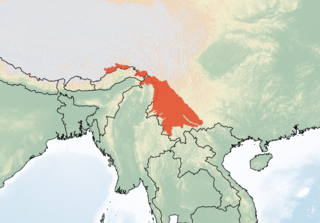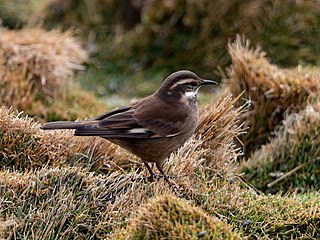The Paraná grass mouse is a South American rodent species of the family Cricetidae. It is found in northeastern Argentina and southeastern Brazil.
Akodon budini, also known as Budin's akodont or Budin's grass mouse, is a species of rodent in the family Cricetidae. It is found in the Andes of northwestern Argentina and adjacent Bolivia. The species is named after Emilio Budin, an Argentine specimen collector who worked with Oldfield Thomas.
Andalgalomys is a genus of rodent in the family Cricetidae. It contains the following species:
Pearson's chaco mouse is a species of rodent in the family Cricetidae. This mouse is found in the Gran Chaco ecoregion of southeastern Bolivia and western Paraguay at elevations up to 400 m. The species is named after American zoologist Oliver Payne Pearson. Its karyotype has 2n = 76 and 78 in the two subspecies. The latter is the highest diploid number of any species in the tribe Phyllotini.

The white-footed vole is a species of rodent in the family Cricetidae. It is found only in the northwest United States. Its natural habitat is temperate forests.
The Bolivian vesper mouse is a species of rodent in the family Cricetidae. It is found in Argentina, Bolivia and perhaps Peru.
The Alai mole vole is a species of rodent in the family Cricetidae. It is known only from Kyrgyzstan, where it has been found in temperate grassland in the Alai Mountains. Little else is known about the vole.
Pratt's vole, also called the Sichuan red-backed vole, is a species of rodent in the family Cricetidae. It is endemic to Mount Emei, Sichuan, China. It was named in 1891 for Antwerp Edgar Pratt.
Peterson's chinchilla mouse is a species of rodent in the family Cricetidae and is found in west central and southern Argentina and nearby areas of Chile. The species is named after American paleontologist Olaf A. Peterson (1865–1933).

Handleyomys alfaroi, also known as Alfaro's rice rat or Alfaro's oryzomys, is a species of rodent in the genus Handleyomys of family Cricetidae. It is found in Belize, Colombia, Costa Rica, Ecuador, El Salvador, Guatemala, Honduras, Mexico, Nicaragua, and Panama. It was previously included in Oryzomys as Oryzomys alfaroi. Its natural habitats are subtropical and tropical lowland or montane dry forests at elevations ranging from sea level to 2500 m.

Handleyomys chapmani, also known as Chapman's oryzomys or Chapman's rice rat, is a species of rodent in the genus Handleyomys of family Cricetidae. It is found only in Mexico. It was previously placed in Oryzomys as Oryzomys chapmani, but has been provisionally transferred to the genus Handleyomys pending the description of a new genus to contain it.
The Mexican harvest mouse is a species of rodent in the family Cricetidae. It is found in Colombia, Costa Rica, Ecuador, El Salvador, Guatemala, Honduras, Mexico, Nicaragua, and Panama in a variety of habitats at altitudes from sea level to 3800 m.

Clarke's vole is a species of rodent in the family Cricetidae. It is found only in China. It is named after Colonel Stephenson Robert Clarke.

Olrog's gull is a species of gull found along the Atlantic coast of southern Brazil, Uruguay, and northern Argentina. It was formerly considered a subspecies of the very similar L. belcheri. It is a large gull with a black back and wings, white head and underparts, a black band in the otherwise white tail, and a yellow bill with a red and black tip. Nonbreeding adults have a blackish head and a white eye ring. The species is named after Swedish-Argentine biologist Claes C. Olrog. It has a rather restricted breeding range and is threatened by habitat loss, and the IUCN has rated it as being "near threatened".

Olrog's cinclodes is a species of bird in the Furnariinae subfamily of the ovenbird family Furnariidae. It is endemic to Argentina.
Nectomys grandis, also known as the Magdalena-Cauca water rat, is a nocturnal, semiaquatic species of rodent in the genus Nectomys of family Cricetidae. It is found in western and northern Colombia at altitudes from sea level to 2000 m, including the basins of the Magdalena, Cauca and Porce rivers. It has two subspecies, N. g. grandis and N. g. magdalenae.
Roig's pericote or Roig's chaco mouse is a species of rodent in the family Cricetidae. Its karyotype has 2n = 60 and FN = 120. It may be a subspecies of Olrog's chaco mouse.

Olrog's four-eyed opossum is a South American species of opossum endemic to eastern Bolivia, first described in 2008 based on specimens collected in 1974. It inhabits the lowland Amazon rainforest, with an elevation range of 150 to 250 m. The species is named after Swedish-Argentine biologist Claes C. Olrog. It is sympatric with P. opossum, which it resembles. The two species differ in several ways, such as ventral fur color and condition of the zygomatic arch.
Geoxus annectens, also known as Pearson's long-clawed akodont or Pearson's long-clawed mouse, is a species of rodent in the tribe Abrotrichini of family Cricetidae. Molecular data suggests that its closest relative is Geoxus valdivianus. Formerly classified in its own genus, Pearsonomys, named after American zoologist Oliver Payne Pearson, it was moved to Geoxus in 2016 after a morphological and genetic reevaluation of the tribe Abrotrichini. This rodent is endemic to Chile, where it is found in Nothofagus forest of the Valdivian temperate rainforest ecoregion.
The delicate salt flat mouse is a sigmodontine rodent species in the family Cricetidae from South America. It is the only species in the genus Salinomys. Its habitat is scrublands bordering salt flats in the Monte Desert area of central western Argentina at elevations around 400 m. The closest relatives of the species are the chaco mice (Andalgalomys).







